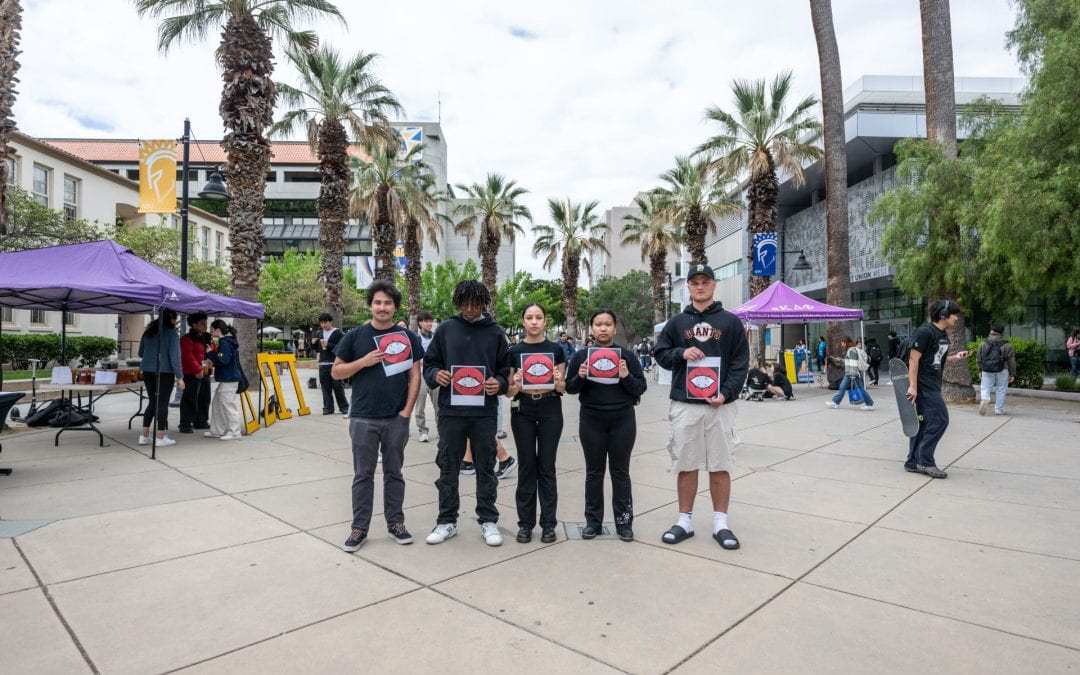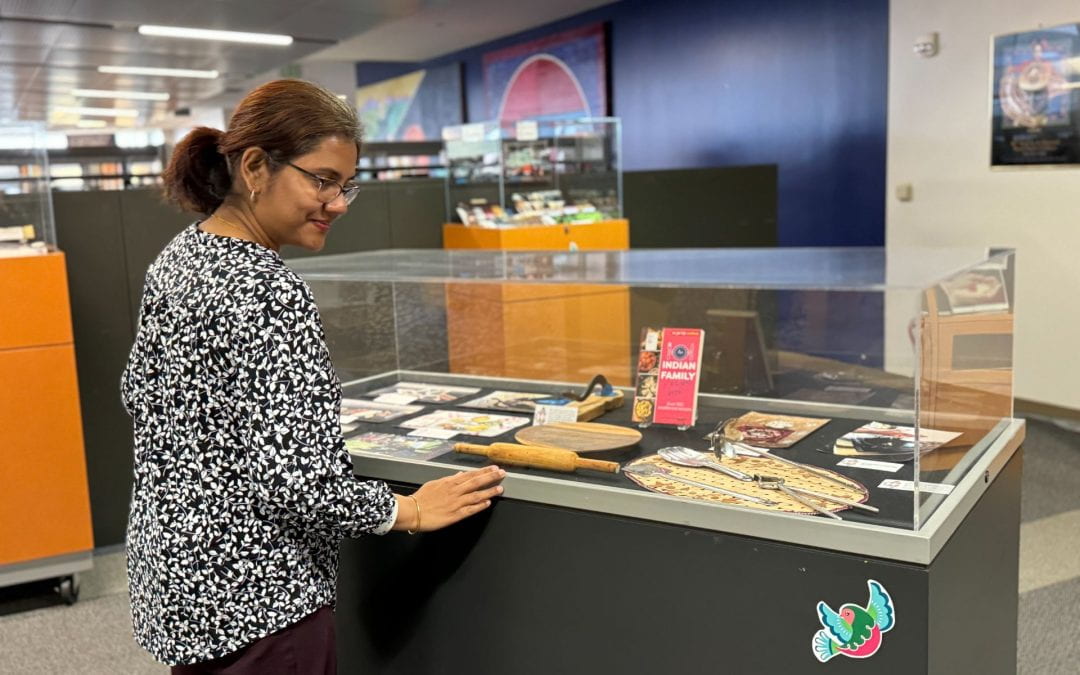Day of Remembrance Recognizes the Impact of the Incarceration of Japanese Americans During World War II

The Day of Remembrance concluded with a walk to visit Ruth Asawa’s Japanese Internment Memorial statue in front of the Federal Building in downtown San José. All photos in this story by Jim Gensheimer.
Eighty-two years ago this week, more than a thousand people of Japanese descent were instructed to report to what was then San José State’s gymnasium in response to President Franklin D. Roosevelt’s Executive Order 9066, which forced more than 100,000 Japanese Americans to relocate to incarceration camps during World War II.
Decades later, as generations continue to process and unearth the trauma of their parents, grandparents and fellow citizens, San José State President Cynthia Teniente-Matson issued a Presidential Directive to commemorate the Day of Remembrance. On Monday, February 19, members of the SJSU community attended this year’s Day of Remembrance at the Hammer Theatre, co-sponsored by the Center for Asian Pacific Islander Student Empower (CAPISE), Asian American Studies and other departments across campus.*
“I sit in my office from time to time, wondering what challenges we face as leaders, all of us in our community,” said Teniente-Matson, who this week penned an official apology in the San Jose Mercury News on behalf of the university for its role in facilitating the incarceration of Japanese Americans during World War II.
She reiterated this apology onstage at the Hammer: “On behalf of San José State University, I apologize to the people who were processed through our campus, and to the larger community affected as well, for San José State’s willing participation in the incarceration of Japanese Americans during World War II. As an institution of higher learning, our focus is on education — and while we unfortunately can’t turn back the clock and undo the damage done to so many innocent people, we can at least learn from what happened and make sure those events are never forgotten, let alone repeated.”
The event included four sessions that engaged with the anniversary through the arts, including a screening of the Spartan Film Studios-produced film, “Nisei,” written and directed by Darren Haruo Rae, ’13 Radio-Television-Film; a performance by San José Taiko, a company founded by SJSU alumni Roy and PJ Hirabayashi, ’77 MUP; a panel on the student-led mural initiative “Never Again is Now!”; and a public art tour of Ruth Asawa’s statue honoring the Japanese Americans unlawfully incarcerated during World War II (from the College of the Humanites and the Arts’ Public Art as Resistance in San Jose project).
“Day of Remembrance is important to me because as an Asian American who is not Japanese, I understand that who I am today and how I am able to live is rooted in the history of Japanese American incarceration and the decades of advocacy that followed to right this injustice,” shared Jinni Pradhan, director of CAPISE.
The importance of sharing stories
The Day of Remembrance event exists in part thanks to former Associated Students president Nina Chuang, ’23 Food Science, who last year introduced a Sense of Senate resolution that institutionalized the Day of Remembrance at SJSU. By making this day a permanent fixture on campus, Chuang hopes to see future students carry on the work that she and others started.
In 2022, Chuang assembled a committee of San José residents, SJSU students, staff and faculty to organize a mural initiative on the side of Yoshihiro Uchida Hall. The piece, which they hope to commission in partnership with the local community, is intended to recognize and commemorate what happened at SJSU more than 80 years ago. They are actively seeking funders to support the project.
“It’s really important that younger generations, we keep the history [of the incarceration of Japanese Americans] alive — to make sure that we not only talk about it, but that we are also able to tell our stories,“ said Jake Shimada, ’26 Business Management, a member of the Never Again is Now mural committee, during one of the panels.
- San José State President Cynthia Teniente-Matson offered a formal apology on behalf of the university for its role in facilitating the processing of Japanese Americans for incarceration during World War II.
- SJSU Archivist Carli Lowe (far right) demonstrated the role that Special Collections and Archives can have in understanding history.
- Nina Chuang, ’23 Food Science, has led the charge for establishing a mural commemorating the incarceration of Japanese Americans.
- A still from “Nisei,” the short film written, produced and directed by SJSU alumnus Darren Haruo Rae.
- San Jose Taiko, founded by two SJSU alumni, has a longstanding relationship with the university.
- Santa Clara County Supervisor Cindy Chavez, ’87 Political Science, spoke at the 2024 Day of Remembrance.
- SJSU Vice President of University Advancement Judy Nagai shared her family’s story of incarceration during World War II.
- From left to right: Carolyn Hamasaki Brown, ’71 Nursing, of the Japanese American Museum of San Jose; Jake Shimada, ’26 Business Administration; SJSU Film and Theatre Lecturer Nick Martinez, ’02 Radio, Television and Film; SJSU’s Director of Production for Film and Theatre Barnaby Dallas, ’00 MA Theatre Arts; and SJSU Assistant Professor of Asian American Studies Trung Nguyen, in conversation following the screening of “Nisei.”
How universities can help keep memories alive
Events like the Day of Remembrance help resurface difficult memories. SJSU Vice President of University Advancement Judy Nagai shared how Executive Order 9066 forced her father out of his California home and to one of the largest incarceration camps in the nation — the same one where the family of Yoshihiro Uchida, ’47 Biological Sciences, ’04 Honorary Doctorate, was imprisoned while Uchida served in World War II.
“As an older son, my father had to work to help raise his younger brothers after his parents passed away, so his circumstances did not allow for him to pursue a college degree,” Nagai said. “As we commemorate the Day of Remembrance, let us honor the memory of those who endured this stark chapter in U.S. history.”
The day concluded with a walk to Ruth Asawa’s bronze sculpture in front of the Federal Building, where SJSU Gallery Director and Collections Manager Alena Sauzade explained the cultural significance of the relief, which depicts the forced removal of Asawa’s family from their home. The tour ended at Yoshihiro Uchida Hall, where SJSU Archivist Carli Lowe shared the role that Special Collections at the Dr. Martin Luther King, Jr. Library can play in understanding the lasting impact of events, like the 1942 executive order.
Historically, archives come “with a certain amount of power and privilege,” Lowe said. “The history that we have in the archives often reflects either the perspectives or the priorities of people [in power]. And for that reason, there’s a lot that’s not in there. And that’s something that archivists in this era are working to change, to give more people access to ways to document and preserve what’s important to them, and to everyone.”
Lowe suggested a few SJSU and CSU resources to explore to learn more about the incarceration of Japanese Americans during World War II: Special Collections’ Japanese Internment online exhibit, the Flaherty Collection — Japanese Internment Records and the CSU Japanese American Digitization project.
*The Day of Remembrance was co-sponsored by the Asian American Studies Department, the Asian Pacific Islander Faculty Staff Association, Associated Students Inc., the Center for Asian Pacific Islander Student Empowerment, the College of Humanities and the Arts, the Connie L. Lurie College of Education, the Division of Student Affairs, the Ethnic Studies Collaborative,and the Office of Diversity, Equity, and Inclusion.












